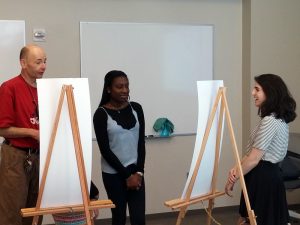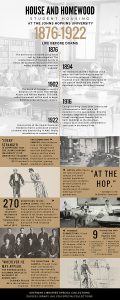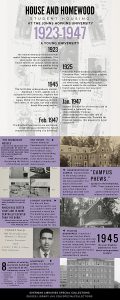
After beginning my freshman fellowship experience last semester, I found myself with a solid foundation of knowledge regarding student housing. The information I had found during the first half of my project seemed to span a variety of time periods, and a wide number of topics, leaving me with even more questions about where my research might take me. Some particular subjects that I wanted to research further included the history of integration on campus and the changing roles of fraternities. In addition to more particular topics such as these, however, I also wanted to see a larger picture about how housing has changed since Hopkins’ founding. As I continued my research into the spring, I looked to expand my knowledge on these specific areas in order to create a more encompassing view of the changes to student housing and how they interacted with student life.

During this last semester, I investigated some of these more particular topics, looking at social issues such as diversity on campus, as well as more administrative changes such as the shifting preferences between different housing options, including dorms, apartments, and fraternities. Much of my research progressed in this way–moving on to topics that caught my interest, and discovering the ways in which these issues either influenced or were influenced by student housing.
For example, I also looked at how student transportation has changed over time, especially looking at how different forms of transportation have allowed students to move further away from campus or into new areas of Baltimore. This topic of student connection to the city as a whole is one that I found particularly fascinating, and which reveals much about changing student attitudes. In addition to these more specific areas, I’ve generally looked more closely at certain time periods in order to get a better idea of how changes in housing were influencing individuals and affecting student life in particular ways.

In particular, I especially looked closer at the late 60s and 70s to see how student housing fit in with some of the sweeping social changes that were happening at the time. This time period seemed to stand out to me as a transitional bridge between the earlier years of the campus and the current, more modern atmosphere. For a long time, Hopkins seemed to pride itself in the individuality and informality of the undergraduate programs and seemed to use more resources on building up the reputation of its graduate programs. The 1970s presented a number of opportunities for the university to decide whether this sense of informality would be maintained or if changes would be introduced to accommodate growing numbers of students as well as more and more diverse student populations.
While this time period was particularly interesting, I found that this tension between informality and formality, individualism and community existed in differing forms throughout the history of the university. In fact, I think this legacy is something students still struggle with today. In my own experiences, I’ve often heard students complain about the lack of enthusiasm among students, especially in extracurricular pursuits. Hopkins students can often come off as solely academically-minded, sometimes seeming even apathetic to other issues. I think that this student attitude is directly connected to our roots in the European research institute model and the individualism that has long been the prevailing atmosphere at Hopkins. Changes in housing have always seemed to accompany and influence these changes in mood and created new and growing opportunities for community at Hopkins.
